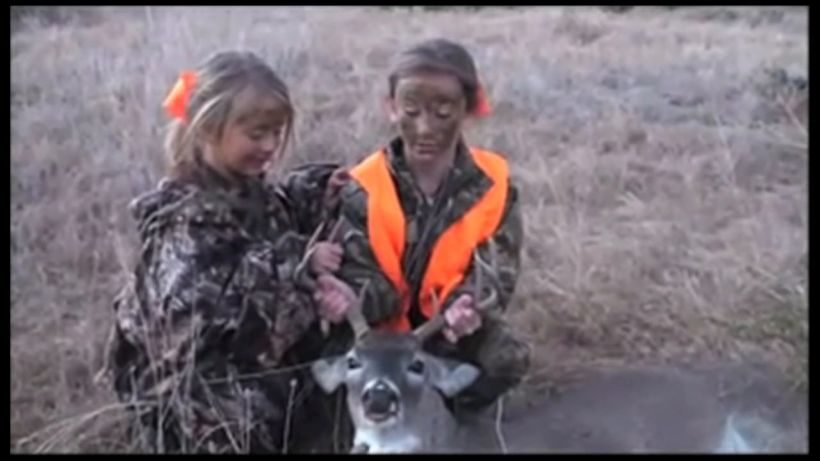
BUCK FEVER © NEOZOON
Just a lovely animal. In “Buck Fever”, a video work from the NEOZOON female artist collective, armed people kill non-human animals for pleasure, and then pose beside the carcasses for the camera. A mixture of pride, misguided presentation rabidness and blindness is revealed in their gestures and words, as their bodily movements at several moments seem to confuse their world view with that of a creature living freely and exceed their powers of imagination. The work underscores especially that which is repetitive and hints at the universal: The ritualist and the stereotypical. Proud to belong to the dominant species, the pause before the shot. With children recurring, learning to kill from their parents. Pawing to feel the bodies. The heads and antlers turned to the camera. Incredible looks at the gigantic carcasses. Handshakes. Demonstrations of love. A montage of found impressions that unmask themselves in their drasticness like a disheartening caricature.
When reality reveals its constructs via the circuitous route of the image, cinema becomes most powerful and discovers its greatest possibility: The view of the world that enhances people and their appearances above and beyond natural perception. Frequently, the cinema system strives for the opposite in its widest-reaching forms and defends appealing, conservative reveries. “No animals were harmed in the making of this movie”, the American Humane Association (AHA) states in the closing credits to Peter Jackson’s “The Hobbit: An Unexpected Journey”, after about 30 animals lost their lives during the shooting. Like many facets of social life, art and the cinema are borne by industries that are not especially interested in truths and critical confrontations. Even in left-wing film practice, films by Michael Haneke, Kim Ki-duk, Lars von Trier, Carlos Reygadas, Jean-Luc Godard, Park Chan-wook, Naomi Kawase, Alejandro González Iñárritu, Andrei Tarkovsky and many more reflect that art is no non-coercive space and has unrestricted use to the lives of non-human animals, and is permitted to kill and abuse them at will. It is not infrequent that the artistic and the ethical are opponents of equal standing.
In their interdisciplinary work, NEOZOON break with the complicity in art production and power structures by making speciesist[1] and capitalist repression routines the centre point of their aesthetic research. They demonstrate via monitor and movie screens, galleries and public urban spaces how Darwinian and market-conform thinking counts as daily bread in human life and consumption worlds. Installations reveal, for instance, surreally deformed animal carcasses, powered ghost-like by machines. Fur coats are recycled to become the material for subversive new appropriations: In the Münster zoo, NEOZOON installed the imaginary coat-animal species behind bars and filmed the speculations of the passers-by (“Das Manteltier”/The Coat-Animal, 2010), who attentively read the satirical text box beside the glass. They used the remains of fur to create the contours of peri-urban animal species in suggestive poses and stuck them to building facades (“Fur Coat Recycling”, 2009-2012 / “Spanish Riding School”, 2011 / “Bah Bah Black Sheep”, 2010, “Les Gout des Bêtes”, 2010), they agitated with scraps of fur in the armpits and on the private parts of women’s bodies on advertising posters (“Hairy Women”, 2011-2012), or filled the shelves of supermarkets with imaginary products, such as cattle teeth and hedgehog jelly (“Food Products” 2011-2013).
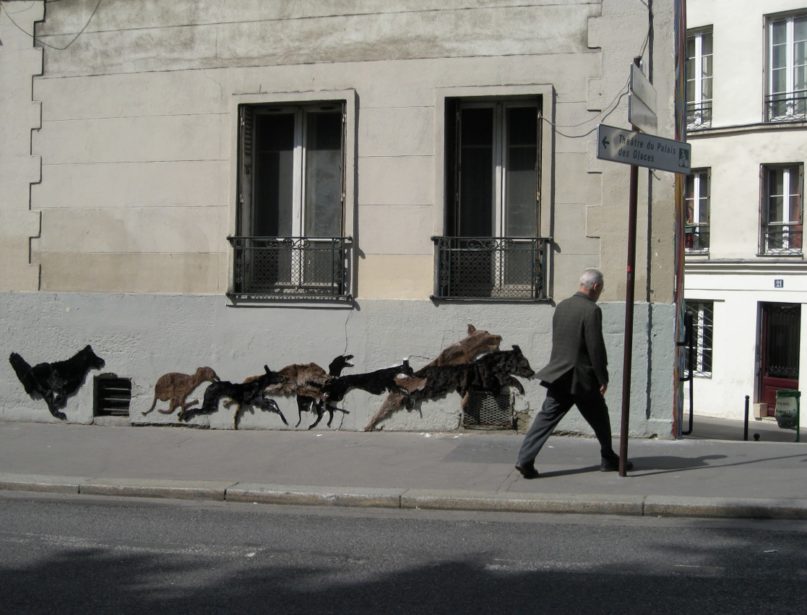
FUR COAT RECYCLING 2009 – 2012 © NEOZOON
The relationship between the living creatures has become an ambient noise of unnaturalness in the centres of civilisation. Instead of producing unnatural contra images once more, in their video works NEOZOON seek out those impressions in which the humans already reveal themselves over-blatantly in their absurd relationship with other living creatures. With reality appearing as a kind of over-shaping, YouTube acting as a central source of resistant archival work and revealing itself in complex montages as an echo chamber of internalised behavioural patterns of the average population.
In addition to the cycle of hunting and killing broached at the start (“Buck Fever”, 2012 / “Big Game”, 2013 / “Shake Shake Shake”, 2016), a second focal area concentrates on private space (“Good Boy – Bad Boy”, 2011 / “Unboxing Eden”, 2013 / “MY BBY 8L3W”, 2014 / “Call of the Wild”, 2017 / “Love Goes Through the Stomach”, 2017) and ultimately shows the humans themselves as “pets”. By contrast, non-human animals appear as voiceless commentators, both alive and dead, processed and unprocessed, trained and sorted in a domestic secret life.
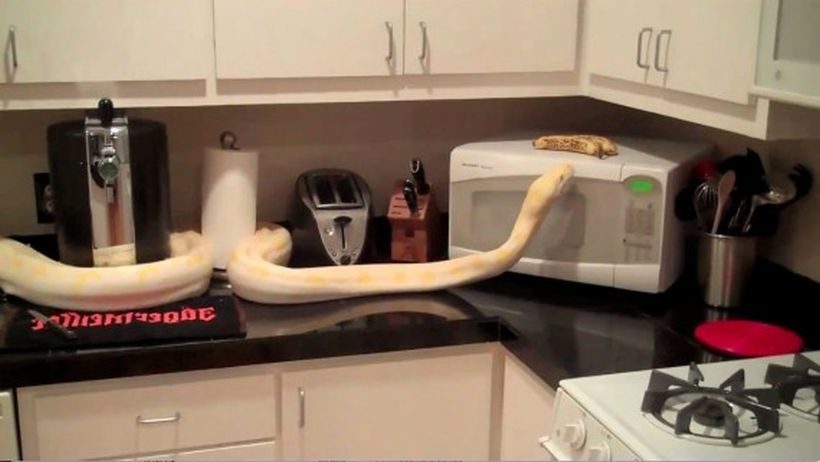
UNBOXNIG EDEN © NEOZOON
What is probably the largest screen presence in a work from NEOZOON is that of a huge snake carried around by American breeders during a reptile show – or at least trying to. “See, we’re not man enough to handle it,” one of the guys says. A strange public performance of human failure, warily watched by the show visitors standing around. Likewise, what this person says of course betrays more about human psychology than about the state of the animal. The huge phallus does not let itself be mastered and assumes the complete image frame against the resistance of strong arms that should maybe compensate for it somewhat. With “Unboxing Eden”, NEOZOON arouses the need most urgently to perhaps see people devoured by their favourite animals.
The editing occurs here and in the other video works like in a thesis – honing aspects that are similar and mutually reinforce each other, sharpening the feeling for interconnections. For instance, there is a concentration on the animal as a product at the start of “Unboxing Eden”: Boxes arrive at the collectors who are looking forward to the snakes packed inside. Their cautious unpacking bring small specimens to light as new boarders. Some of them accept their fate, while others merely bite at the hands in a helplessly aggressive way. Meanwhile, the humans assess, comment on, weigh, sort out and fantasise about them. Here too: The pleasure in savouring their own supremacy. With the purchased exotic animals encountering conventional suburban homes mostly in America, and narrow horizons. For the snake owners, filming themselves on YouTube becomes a self-assertion in a world that seems to have little interest in them otherwise.
Yet for that, NEOZOON does not show the human as a perpetrator, but rather equally so as a deluded victim of grander narratives. At the latest in “Love Goes Through the Stomach”, when supermarkets tout chicken legs with exuberant promises of happiness and special offers, psychological states intermingle with bodily needs. And thus the love of chicken becomes absentmindedly confused with a well-spiced drumstick here, while in “MY BBY 8L3W” and “Good Boy – Bad Boy”, the responsibility for animals becomes an obsession that creates a blindness for dependencies and domestic realities of violence. In the consumer society sketched out by NEOZOON, being a human includes a self-trained immaturity to a smaller or greater degree in the inevitability of complicity. In their search for pleasure, self-affirmation and intimacy, the humans reveal themselves before their home cameras as agents of a system that grasps human and non-human life to an equal extent as merely being part of an exploitation logic, and they regularly flee into the support and assistance of their cuddly animals.
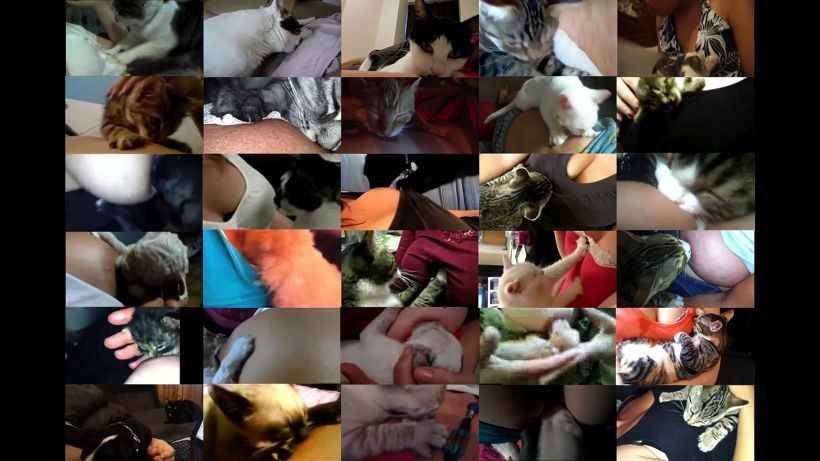
MY BBY 8L3W © NEOZOON
Three other video works focus directly on the fantasies of the large mammals: In “Call of the Wild” (2017), NEOZOON explore YouTubers who turn their inner animals outwards for the camera. Primal screams and feline cuteness articulate a panorama of uncivilised, uncultivated rearing-up that is ironic at times and serious at other times, and which finds its holistic redemption in the crazed screaming of an extreme metal band. Overcoming the human once, to become a demon and fetish object. To establish counter cultures. The brain bores quickly, and not only in the city. The question is that of dealing with free, open spaces. And NEOZOON finds impressive answers. “Little Lower Than the Angels” (2019) reproduces human arrogance and religious fantasies of omnipotence. In the German competition section of the International Short Film Festival Oberhausen, the collective recently presented the video “FragMANts” (2019), in which the female artists have fun deconstructing human bodies and gestures into their individual parts before creating idiotic-vulgar artificial creatures from them in a shared visual framing, like in a jigsaw. An idiocy that emerges from obscure video found footage and the human relationship with products. A kind of collage, in which material already used appears repeatedly and in new arrangements.
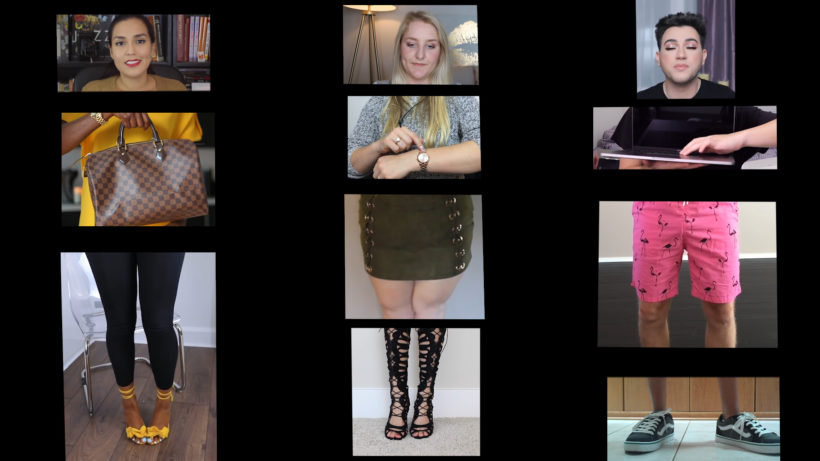
FragMANts © NEOZOON
NEOZOON has existed since 2009, with the female artists in it coming from the visual arts and working in accordance with the principle of consensus in alternating decision-making arrangements. Recycling, a principle in video montage, has been one of their tools from the beginning, as they said in an interview with the arte TV Kurzschluss programme. Since the success of “Buck Fever” which was screened at about 30 festivals (including Rotterdam, Hamburg, EMAF, Kassel and Kiew) – and thus at almost all central platforms for experimental film and video art in Germany – they have gained growing visibility in the cinema and festival business, combined with their first awards and increased production funding. Even if cinema audiences show themselves to be less diverse than are passers-by on the street, NEOZOON still sees a great attraction in the concentrated cinema viewings, which accord works such as “Love Goes Through the Stomach” a greater sharpness.
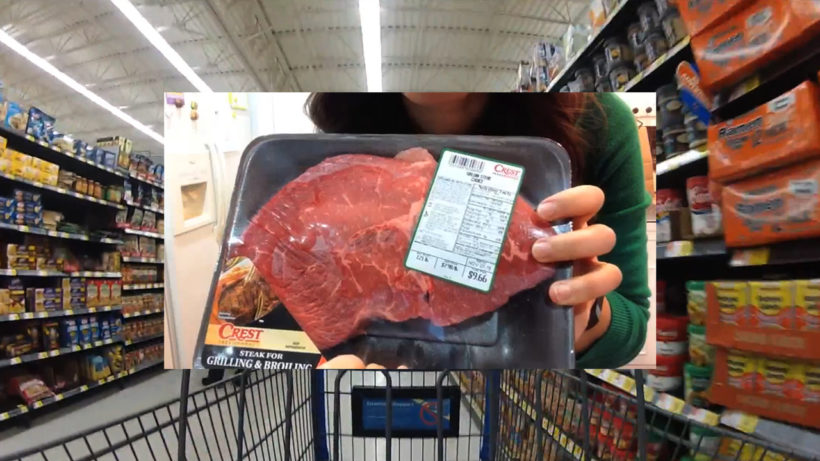
LOVE GOES THROUGH THE STOMACH © NEOZOON
What remains from their initial creative phase is the stylistic device of anonymity especially. Concealing their own names, enveloping their own art in an aura of audacity and criminalisation: These are the common strategies of the street art scene that NEOZOON appropriated for their erstwhile fur agitations and then continued playfully. Their names currently being hidden is certainly practical, because transgressions by the collective can be found today in their daunting handling of film footage, whose legal status on YouTube may be regarded at least as similarly unclear. In the experimental film area, it seems that the rules of appropriation are more relaxed nowadays, while the freedoms tolerated by festivals, however, remain unwritten laws and ultimately offer no one security.
NEOZOON supercharge their works with combativeness, yet they have little interest in a didactic reading of their oeuvre. What happens before the camera is central in their video works: The audio-visual space of experience with all its misunderstandings. In the best moments, an inventory of the present and the speciesist behavioural patterns of people today are achieved. Once more: What happens before the camera is essential. Which is also how the American Humane Association argued about the Hobbit movie, because the sheep killed during Peter Jackson’s shoot did not die, after all, neither in front of nor for the camera. Thus the film is morally impeccable. A PETA lawsuit two years ago against one of the largest suppliers of film animals in Hollywood shoots provoked the exact opposite reaction in the company concerned: Birds & Animals Unlimited tried to deny disgraceful animal housing conditions despite obvious video evidence because they did not depict the complete situation. And meanwhile the production companies on movies such as “Harry Potter” or “Game of Thrones” were able to wash their hands of the matter thanks to their AHA certificates. Accepting responsibility is not fashionable in the frequently classic-capitalist, hierarchical and male-dominated movie industry. But fortunately, the image has not yet completely lost its power as a means of evidence.
NEOZOON pose contemporary and underrepresented questions about how to position an agitatory aesthetic against dominant world views and to what extent a feminist artistic practice permits itself to be connected with an anti-speciesist and anti-capitalist one – and they demonstrate perspectives that are, unlike conservative left-wing positions, interested in the emancipation of all ethnic groups and species. Even after 100 years, cinema has still not stopped learning.